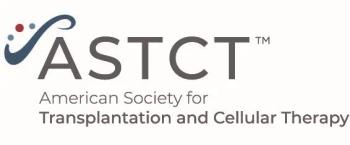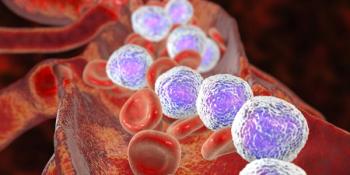
Clinical Implications from REACH3 in Steroid-Refractory Chronic GVHD
Yi-Bin Chen, MD, evaluates the safety and efficacy of ruxolitinib for second-line treatment for steroid-refractory chronic GVHD and discusses clinical implications from the REACH3 trial.
Episodes in this series

Matt Fowler: Looking at the population of patients who are enrolled, 329 patients, could you describe some of the key and common characteristics of that population?
Yi-Bin Chen, MD: We look at the patient population that was randomized in the REACH3 trial. One can see that it was a clearly generalizable population, most in routine transplant practice. There clearly weren’t a lot of pediatric patients enrolled. The vast majority were over 18 years old. About 10% to 15% of patients were over the age of 65, which in my practice is an increasing population that we’re transplanting and we know are at increased risk for chronic graft-vs-host disease. At least half of all these patients had prior acute graft-vs-host disease, which we know is the biggest clinical risk factor to develop chronic graft-vs-host disease. To qualify for the trial, you had to have moderate or severe disease. About half the patients had moderate disease; the other half had severe. There was a mix of related and unrelated donors, which I’m not sure matters much once you have established chronic graft-vs-host disease. Certainly, because patients all had to be steroid-refractory, they had all received systemic steroids. This is a standard population with steroid-refractory chronic graft-vs-host disease that we needed an improvement in options and outcomes.
Matt Fowler: Looking at the main end points that you previously mentioned, what were some of the results from them? Did any of the outcomes that you saw surprise you?
Yi-Bin Chen, MD: The primary end point in REACH3 was overall response at 24 weeks. That was reported out as about 50% of patients in the ruxolitinib arm had an overall response, and only about 25% in the control with best-available therapy did. This was significantly different in favor of ruxolitinib. It’s interesting when you look at how many patients had a complete response or a partial response. That truly illustrates that, while we believe we’ve made significant progress in the treatment of these patients, we have much more to go to improve, because less than 10% of responses were complete responses. That means either organs are already fixed, or we just need better agents to bring about true disease-modifying therapy.
Nevertheless, the difference is very impressive, and for the key secondary end point of failure-free survival, ruxolitinib had a huge benefit in a greater-than-18-month failure-free survival vs less than 6 months for the control arm. Failure free-survival is a composite end point that includes mortality as well as starting a new agent for the treatment of chronic graft-vs-host disease and illustrates the durability of the response as well as the satisfaction of it by patients and providers.
If we look at the safety, there were no red flags in this trial. The main adverse events that were higher in the ruxolitinib arm were cytopenias. We know that inhibition of JAK2 can bring about anemia and thrombocytopenia, so those were expected adverse events that one tolerates when using this agent. And we worry about infections: would we see more infections? We did not when using ruxolitinib vs best-available therapy. Then when looking at the modified Lee Symptom Scale, our patient-reported outcome, one could see that more patients during this trial at any point had a response, meaning a benefit in the modified Lee Symptom Scale vs best-available therapy.
Stephanie Lee, who’s 1 of the authors on this trial, presented an update of the patient-reported outcomes at this year’s ASH [American Society of Hematology Annual Meeting] in 2021, where she took a deep dive into these patient-reported outcomes on this trial. What was interesting was that not only was there a higher number of patients who experienced a benefit on the modified Lee Symptom Scale with ruxolitinib, but if you took only patients who had a response in ruxolitinib vs best-available therapy—even in that subset who had a clinical response—those who received ruxolitinib had a much better response on the modified Lee Symptom Scale. What that suggested was that even among the patients who were classified as a PR [partial response], the actual clinical response that made a difference was much higher in the ruxolitinib arm. Those are powerful data. I wouldn’t say I was surprised by any of this. We knew that ruxolitinib was very efficacious in this population and also safe to use, so I wasn’t surprised by many of these end points. I was happy to see this trial done, knowing that it would pave the way to get access for more of our patients.
Matt Fowler: When looking at these end points like response and failure-free survival, how do you anticipate you’ll be able to apply these data into your everyday clinical practice?
Yi-Bin Chen, MD: The data itself from REACH3, while not surprising, validate what we were doing in our clinical practice over the last few years. At that point in my mind, ruxolitinib was the standard for second-line therapy for chronic graft-vs-host disease for patients in whom steroids are not efficacious or who need to be spared exposure to some steroids because of certain comorbidities. I don’t necessarily share the data with patients in the sense that I’m not sure how meaningful this would be to them practically. It gives us confidence that we’re doing the right thing with all the options we have by prescribing ruxolitinib. It also lets us know, maybe after a few months, if it’s not working, so we can move on to something else. It also gives us expectations that we shouldn’t expect complete responses. We knew that already, but this trial definitely shows that. It gives us confidence that the response that we’re achieving, at least clinically and categorizing in our notes, is making a difference in overall quality of life for our patients.
That’s how it’s bolstered our practice in terms of these results. Obviously, these results paved the way for regulatory approval. We’re able to get the drug for more of our patients, and that’s been the biggest difference.
Transcript Edited for Clarity
Newsletter
Stay up to date on recent advances in the multidisciplinary approach to cancer.


















































































